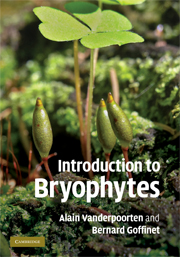10 - Conservation biology
Published online by Cambridge University Press: 05 June 2012
Summary
The major environmental changes that bryophytes are facing (Chapter 10) have increasingly brought about concerns for their conservation. Conservation biology is a fairly new, multidisciplinary science that has developed to deal with the crisis confronting biological diversity (Primack 1993). As a crisis discipline, conservation biology appeared in response to a rising political demand to face the dramatic loss of biodiversity and the need to take steps to anticipate, prevent and reverse the trend (Heywood & Iriondo 2003). Subsequent ratification of the ‘Convention on Biological Diversity’ at the United Nations conference held in Rio in 1992 by most of the world's governments has placed the subject of biodiversity firmly on the political agenda.
The development of the concept of conservation biology is closely interrelated with that of biodiversity. Biodiversity is defined in the Convention on Biological Diversity as ‘the variability among living organisms, from all sources … and the ecological complexes of which they are part’.
In this broad conservation picture, bryophytes were initially completely overlooked. Cryptogams in general were, for example, the focus of only about 4% of published papers between 2000 and 2005 in leading conservation journals (Hylander & Jonsson 2007). The situation has, however, been changing recently and there has been an increasing awareness of the necessity to include cryptogams in general, and bryophytes in particular, in conservation programmes (Hylander & Jonsson 2007).
- Type
- Chapter
- Information
- Introduction to Bryophytes , pp. 232 - 255Publisher: Cambridge University PressPrint publication year: 2009
- 3
- Cited by



